 Do you plan to sell goods online worldwide? If so, you may want to think about providing users with currency conversion.
Do you plan to sell goods online worldwide? If so, you may want to think about providing users with currency conversion.
Currency conversion allows your customers to have the price of an international currency transaction translated to their local currency when checking out products online. It also lets customers see the exact amount their credit card or PayPal account will be charged, expressed in their home currency.
One benefit of adding currency conversion to your site is that it allows your customers to view and understand prices in foreign countries in their own home currency, making it it easier for visitors to work out their costs and expenses.
If you are a WordPress user, it’s easy to add a currency converter to your WordPress web site, allowing your customers to easily understand the cost of your goods.
Currencyr – WordPress Currency Conversion Plugin
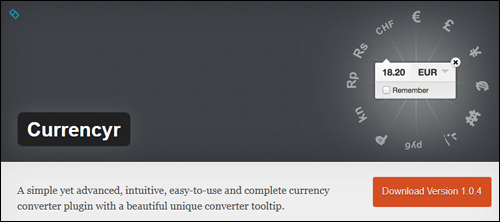
Currencyr is a simple yet advanced, intuitive, easy-to-use and complete currency converter plugin with a beautiful and unique converter tooltip. And, it’s also free to install and use on your web site.
Plugin features include the following:
- Inline converter
- Supports various exchange rates providers, like Yahoo!, Google, Open Exchange Rates, European Central Bank and FoxRates
- Supports Shortcodes
- Widgetized currency table and converter
- Supports integration with various e-commerce plugins such as WooCommerce, WP-eCommerce and Easy Digital Downloads.
- Can detect local currency automatically
- Translation support
Note: This plugin needs your server to be running PHP 5.3.0 or later. Do not install this plugin if you are running an older version of PHP on your server. Ask your web host to check and upgrade your PHP.
***
You can install the Currencyr plugin from your WP admin area by searching for “currencyr” in the Plugins area and clicking the “Install” button …
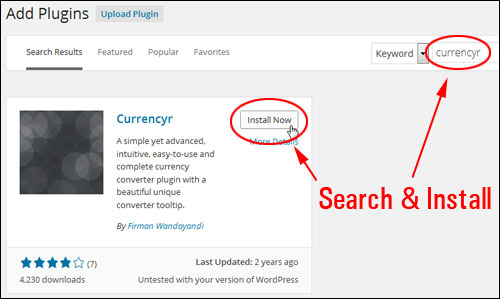
After installing and activating the plugin, you can configure the plugin’s settings by selecting Currencyr from your admin user menu …
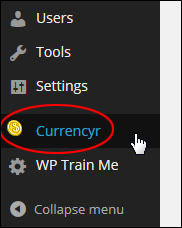
This takes you to the plugin settings area …
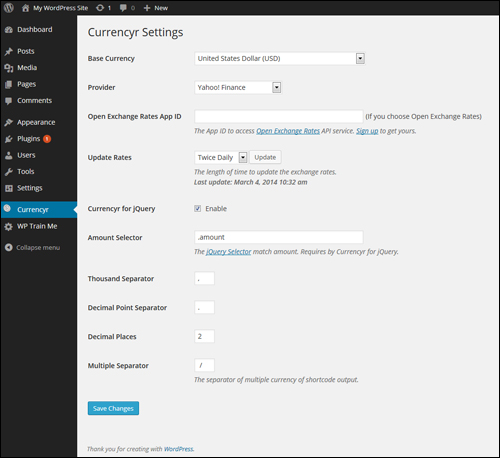
For example, you can select your base currency from a drop-down menu. The default base currency is ‘USD’ …
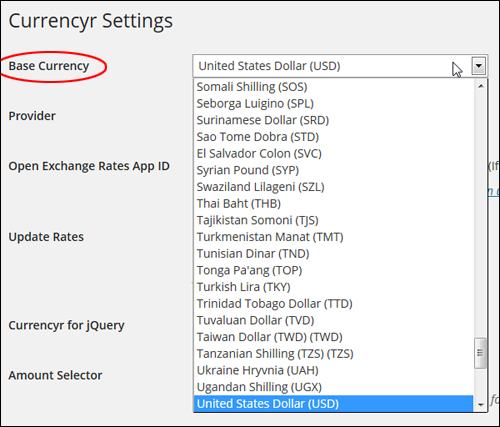
Similarly, you can choose a data provider from the drop-down menu in the Provider section. The default provider is ‘Yahoo! Finance’, but you can choose another option, such as FoxRate or Open Exchange Rates …

Note: If you select Open Exchange Rates as your provider, an API (Application Programming Interface) is required …

You can specify how frequently you would like to update the exchange rates by selecting an option from the ‘Update Rates’ dropdown menu …

The Currencyr plugin uses jQuery, which lets web developers add things like animation effects to web applications (like WP plugins).
Unless there is a reason to modify the jQuery settings, leave these as they are …

Edit the remainder of the plugin settings and click Save Changes when finished …
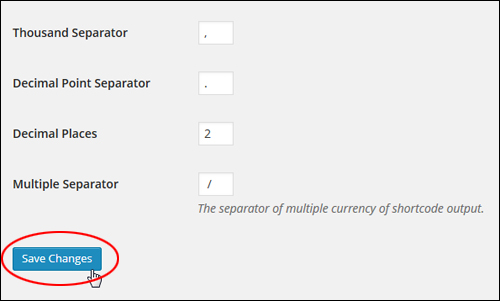
Once you have finished configuring your plugin settings, you can easily add currency conversion to any of your WP posts using a shortcode.
See the ‘Additional Plugin Notes’ section further below to learn how to use currency codes (e.g. USD, GBP, JPY, etc …) with this plugin.
How To Use Currencyr Shortcodes
You can easily add currency conversion to posts, pages and widgets with no technical knowledge using shortcodes.
Below are some examples of currency shortcodes that you can add to pages and posts:
Let’s say that you retail goods on your website for a set amount (e.g. $175) in US Dollars (USD), and you want to display the price converted into British pounds (GBP) on your sales page.
To display this information, simply add the following shortcode into your post or page …

Note: You can also add amounts in dollars and cents (e.g. 165.49, 97.00, 295.75, etc …)
The screenshot below shows how the above shortcode should look when added to the page …
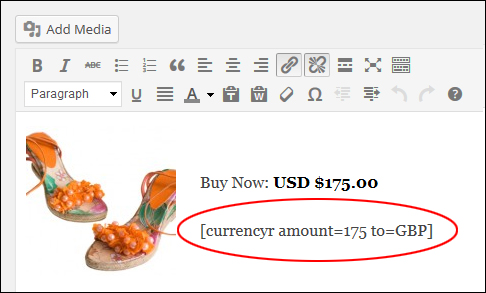
Once the page has been published, your converted currency amount will then display as you can see in the example below …
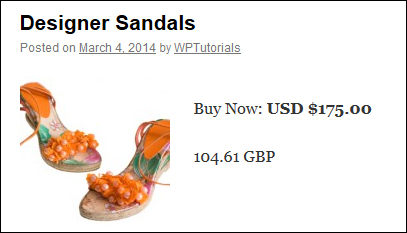
Using the same example, let’s now translate the same price into multiple currency formats.
To do this, use following shortcode (add as many currency symbols as you like by using vertical pipes) …

The example below shows how the above shortcode appears when added to a post …

Once the page or post has been published, the converted currency will then appear as you can see below …
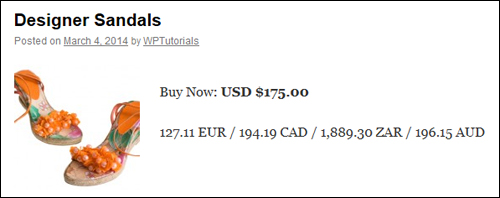
See the ‘Additional Plugin Notes’ section further below to learn more about changing the currency separator symbol with the Currencyr plugin.
Now, let’s suppose that you would like to specify a different base currency than the one selected as the default.
For example, if you have specified your default base currency as EUR and you have a section on your e-commerce pages targeted to non-European customers (for example, Australia or Canada), you can change the base currency using the following shortcode …

Here’s how the above shortcode looks when you add it to a post …
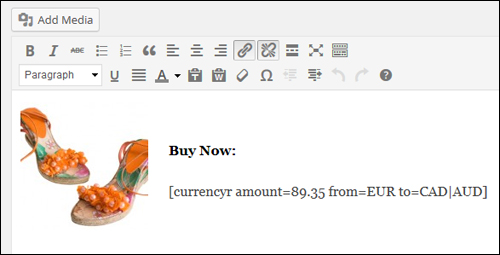
After publishing your post, your converted currency will then display like this …

Using The Plugin Widget
You can also add currency conversion to your website or blog’s sidebar using the plugin’s widget.
To add currency conversion to your sidebar, choose Appearance > Widgets in the WordPress dashboard menu …
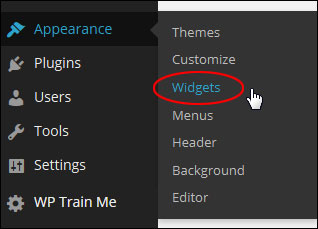
In the Widgets > Available Widgets area find the ‘Currencyr’ widget and drag it to the Active Widgets location …
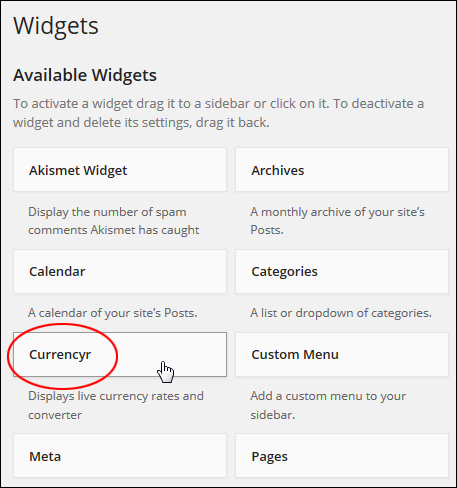
Configure the widget options as shown in the example below (add currency codes separated by commas), and click Save to update your settings …
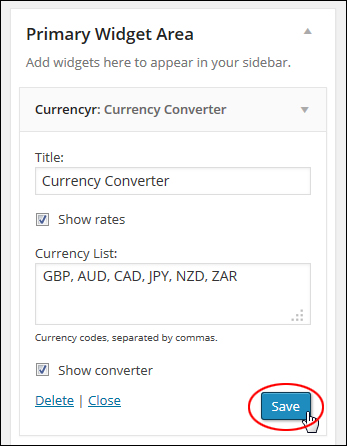
Your currency converter tool will now display on your sidebar with the settings you have selected …
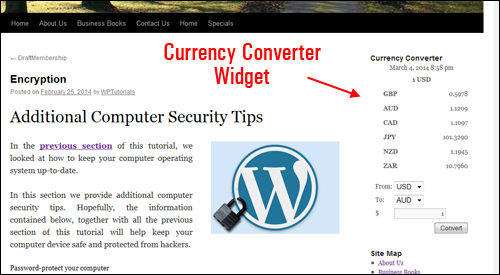
Additional Plugin Notes
Here are some additional notes and useful information about using the Currencyr plugin.
Currency Separator
The Currencyr plugin lets you specify a symbol of your choice to display as the currency separator when using multiple currencies.
You can change the symbol in the ‘Multiple Separator’ settings field.
So, for example, using the default symbol “/” (forward slash) …

Displays your currency values separated by the forward slash as shown below …
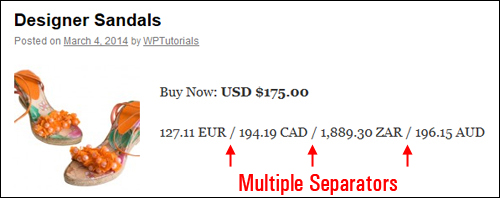
If you modify the symbol and resave your settings …

Your web visitors will see the new symbol being used as the currency separator …
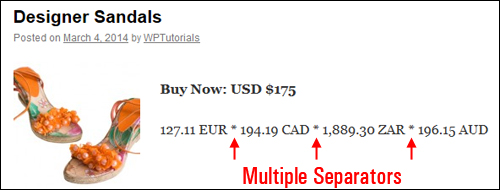
Integration With WordPress e-Commerce Platforms
As stated earlier, the Currencyr plugin can be integrated with a number of WP-compatible e-commerce plugins such as WooCommerce, WP-eCommerce and Shopp …
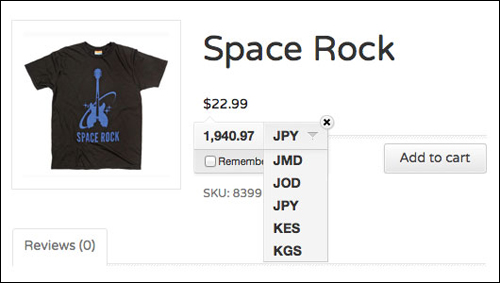
(image source: plugin website)
And there you have it! Now you can go and easily add currency conversion to your WordPress web site.
To learn more about WordPress e-commerce plugins, see the tutorial below:
***
"These tutorials have so much information and are easy to understand. If you use WordPress or plan to in the future these will help you with everything you need to know." - Valisa (Mesa, Arizona)